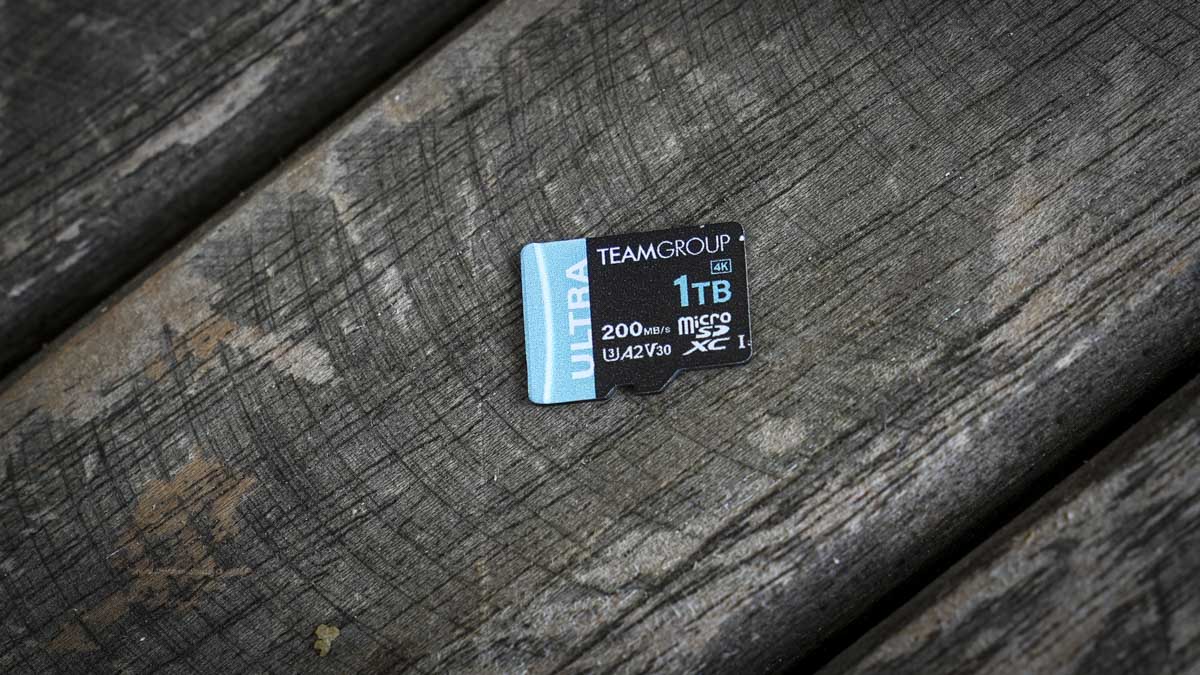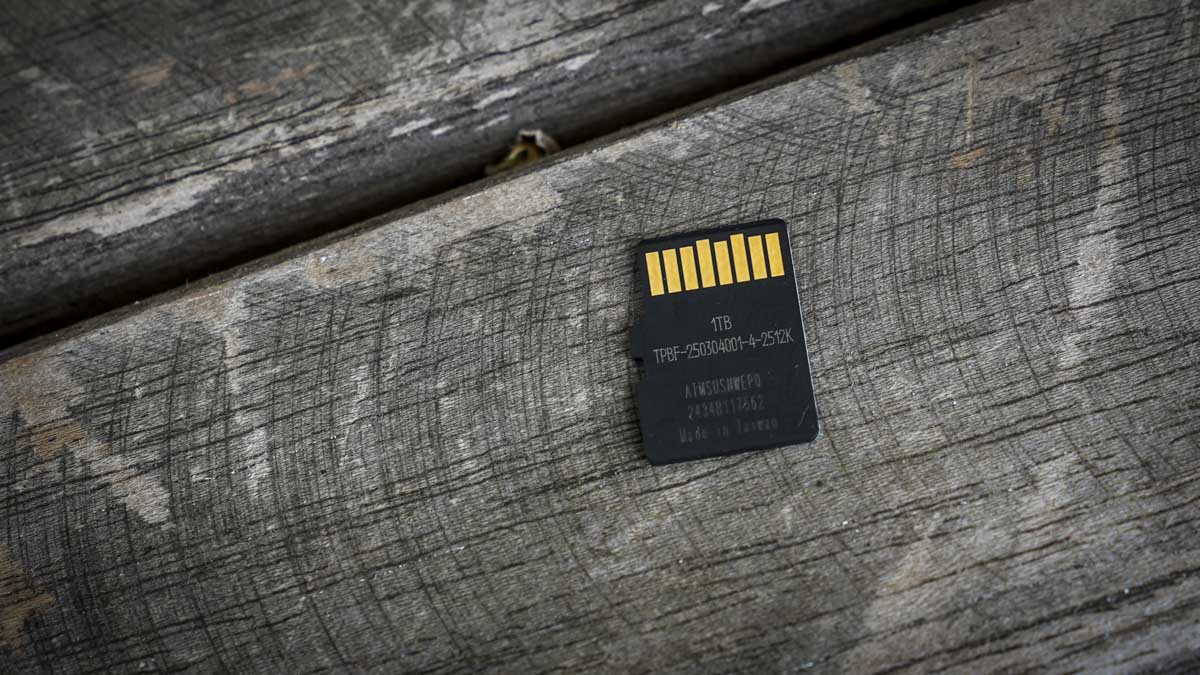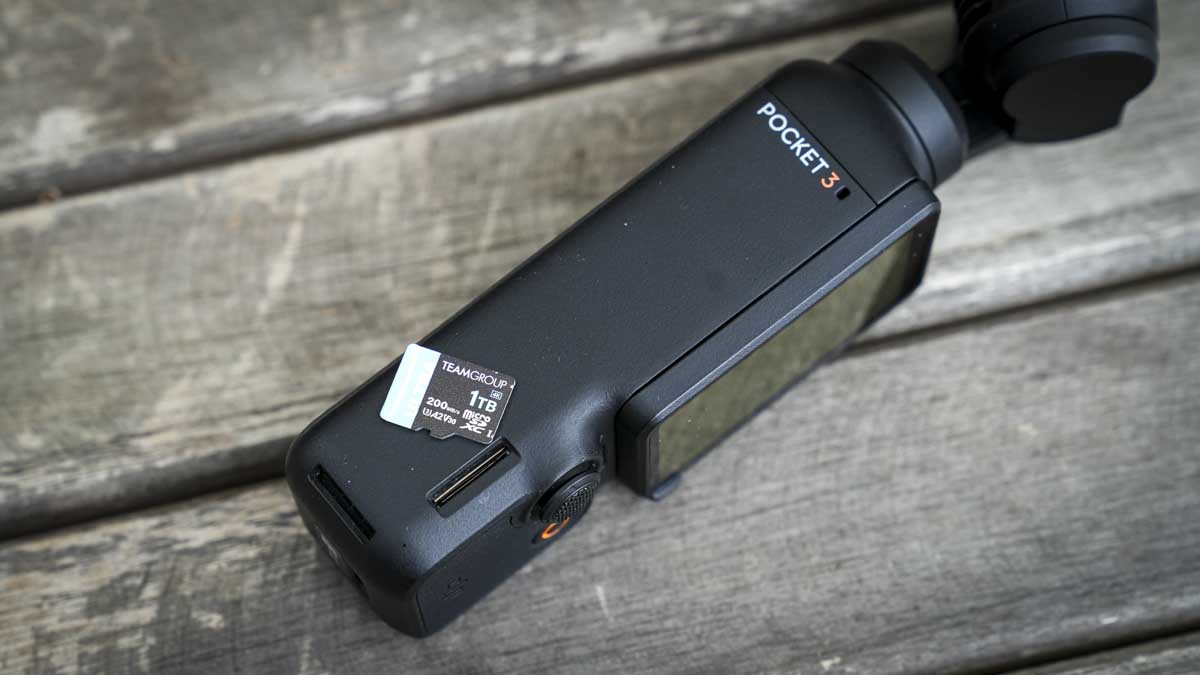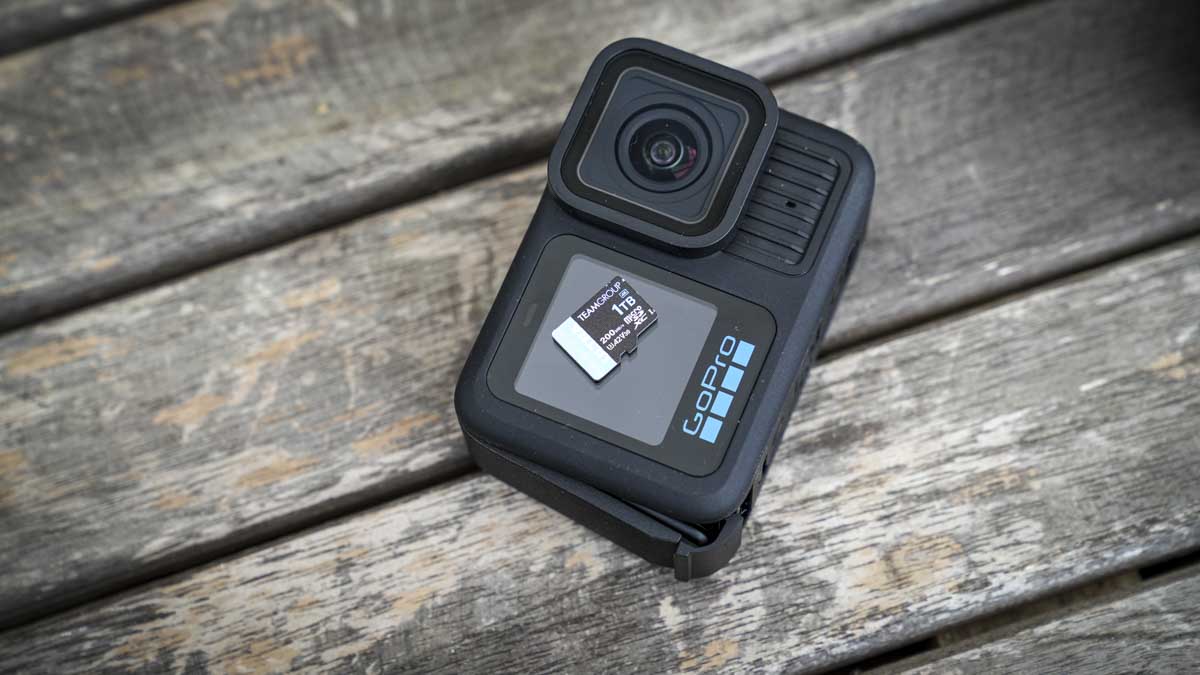TechRadar Verdict
One terabyte is substantial for any flash memory card, and with the DJI Mavic 4 Pro's 100MP Hasselblad camera, serious storage is essential. Benchmarking highlighted decent real-world results, meeting the demands of 4K video from drones and action cameras.
Pros
- +
Huge capacity
- +
Fast transfer rates
- +
Neat graphics
Cons
- -
UHS-I technology
- -
Doesn't quite meet the maximum transfer rate
- -
MicroSD size makes it easy to lose
Why you can trust TechRadar
Teamgroup ULTRA MicroSDXC A2 V30: 30-second review
For a card that weighs less than a gram and to offer a terabyte of storage is impressive, although no longer that unique or rare. The latest microSD card from Teamgroup builds on the company's solid foundation with the Pro and Go cards, and now the Ultra series offers speeds of up to 200 MB/s. This speed should, on paper, at least, be more than enough to cope with the Mavic 4 Pro's impressive camera.
While the card is small, if TeamGroups previous releases are anything to go by, it should be extremely well-priced considering its capacity. Teamgroup opting to stick with UHS-I technology rather than UHS-II will also help to keep costs down while maximising compatibility. The company has also broken through the usual maximum transfer speeds available through UHS-I as long as the card is used with a professional card reader. When it comes to speed, it comes classed with ratings of A2 for apps and the all-important V30 – or Video Class 30 – which is what we need to focus on when looking at imaging devices.
Starting the test with standard benchmarking software and the card puts in a decent performance. This is despite the benchmark results not quite reaching the quoted from TeamGroup. When you consider the Mavic 4 Pro's high-quality camera and the mass of data that it can capture, the card is fast enough to keep up with the maximum quality footage the drone can capture.
Likewise, tested in the GoPro Hero 13 Black, Insta360 Ace Pro 2, and the DJI Osmo Pocket, the small microSD card once again proved more than capable of keeping up with everything I threw at it.
By the end of the test, the small microSD card with its huge 1TB capacity proved more than fast enough for most smaller imaging devices, including drones and action cameras tested. The card's capability was tested with all of those devices – and interestingly enough, DJI actually specifies almost the exact specs of this card for the latest DJI Mavic 4 Pro drone, which means it's an absolutely superb choice.
The only time this card meets its limits is when used with a larger mirrorless or DSLR camera and with a microSD to SD card adapter, where some of the larger 4K and 8K resolution video options would require a step up in speed – but not capacity.
As microSD cards go, and considering this is UHS-I, not UHS-II, the transfer rates are exceptionally good. Whilst they don't quite match the speeds stated by Teamgroup, they're not far off.
Sign up to the TechRadar Pro newsletter to get all the top news, opinion, features and guidance your business needs to succeed!
Teamgroup ULTRA MicroSDXC A2 V30: Price and availability
- How much does it cost? TBC
- When is it out? Now
- Where can you get it? Widely available when released
The full price of the Teamgroup Ultra microSDXC A2 V30 microSD card has yet to be announced, but the 1TB version is likely to be around $120 or £120 if it's to be in line with market competitors. Coming from Teamgroup, this MicroSD card is already distributed through many major retailers, so expect to see it available through B&H Photo, as well as online retailers such as Amazon.
- Value: 4 / 5

Teamgroup ULTRA MicroSDXC A2 V30: Specs
Operation Temperature: -25°C ~ 85°C
Weight: 1g
Dimensions: 72 x 24 x 4.6 mm
Performance (Optimised with a professional card reader): 1TB: Read up to 200 MB/s; Write up to 170 MB/s
Performance UHS-I: 1TB: Read up to 100 MB/s; Write up to 90 MB/s
Teamgroup ULTRA MicroSDXC A2 V30: Design
The Teamgroup Ultra microSD card takes on the familiar compact form factor required by this format of flash memory but manages to stand out with distinct, relatively bright graphics, which I always find useful for a card size that's incredibly easy to lose when used out in the field - unfortunately, as always, that colour way is limited to the top surface with the underside being almost completely black aside from the single row of contacts.
The card has been designed with a focus on the latest imaging devices, such as action cameras, drones and phones, and with the SD adapter, it will work with most mirrorless and DSLR cameras to a point where I'll go more into that later. While the focus of this card is imaging, it will equally fit into any non-imaging focused smartphone or games console with the A2 rating, meaning that it's optimised for use with phone Apps and backed up by that large capacity for media and game data.
During the test, I tested the card's latest range of premium action cameras from GoPro, Insta360, and DJI, and also popped the card into several DJI drones just to check the speed of the transfer rates demanded by these latest 4K and above imaging devices.

I'll cover how the card coped with those cameras more in the performance section, but suffice it to say that, due to its design and the fact that it adheres to the standard specifications of the microSD card format, it fitted and worked seamlessly with all devices tested.
Regarding dimensions, as this is a microSD card, it essentially has to conform to the standard format, weighing in at 1 gram, and measures 11 x 15 x 1 mm, although the site seems to give completely different dimensions to this.
Supporting the durability of the card, Teamgroup has also ensured the card is waterproof, shockproof and comes with a limited lifetime warranty – all helping to reinforce the card's quality.
- Design: 5 / 5
Teamgroup ULTRA MicroSDXC A2 V30: Features
As a microSD card, there is no way of design aside from the graphics that cover the top surface of the card. Physical dimensions are fixed, and as such, it fits into all devices that accept either a TF or microSD card.
The only issue you may come up against is the capacity of the device that you're using the card with. In this test, I selected a range of new devices, all able to recognise up to 1TB in storage. If 1 TB exceeds what your device can read, there is no need to worry, as there are smaller capacities available, including 128GB, 256GB, and 512 GB.
A key selling point of this card is that it's rated with speed classes of A2, U3 and V30 classifications, which essentially means the minimum write speed is 30 MB/s – more than enough for most small imaging devices capable of shooting Full HD or 4K video (although 8K might be a stretch).
The minimum 30 MB/s transfer rate doesn't mean that's the top write speed – in fact, through the test, the card proved that it was capable of speeds significantly faster, which was impressive, especially considering this is a UHS-I card and not a UHS-II card. On paper, using the right equipment, the card actually exceeds the specifications for UHS-I and enables maximum transfer rates of up to 200 MB/. Couple this speed with the huge 1 TB capacity, and you have a very small memory card that can store a significant amount of data fast - making it perfect for imaging.
Alongside the release of the cards, Teamgroup has also launched the Ultra CRI microSD memory card reader, which enables you to plug the card into the base of an iPhone for extra storage, or you can simply use it as a memory card reader to plug into a USB-C port on your computer.
Another feature that stands out – although this is becoming more common among manufacturers – is that Teamgroup also offers a software solution alongside the card. At the time of writing, this software is only available for PC. The T-Create Expert SMART MicroSDXC Smart Tool enables you to verify the integrity of your microSD card, ensuring it's in optimal condition before use in any imaging device.
As a feature set goes for any microSD card, the Teamgroup Ultra microSDXC is well equipped, and the inclusion of optional software – albeit PC-only – does still help to make this memory card stand out against its rivals.

- Features: 5 / 5
Teamgroup ULTRA MicroSDXC A2 V30: Performance
Crystal Disk Mark Read: 167.49 MB/s
Crystal Disk Mark Write: 144.26 MB/s
AJA System Test Lite Read: 157 MB/s
AJA System Test Lite Write: 136 MB/s
AS SSD Benchmark Read: 158.05 MB/s
AS SSD Benchmark Write: 135.59 MB/s
ATTO Disk Benchmark Read: 160.08 MB/s
ATTO Disk Benchmark Write: 136.65 MB/s
To start this test, I popped the Teamgroup Ultra microSD 1TB into the DJI Osmo Pocket 3, and even at the highest resolution and frame rate, this microSD card was more than capable of keeping up with the demands of this small camera.
Wanting to push the limits of the card's transfer rates, I placed it into the GoPro Hero 13 Black. When it came to the video quality settings, I set these all to the maximum, including shooting with advanced GP-Log for a wider dynamic range (which results in much larger files). The first thing to note is that the maximum card capacity recognised by the Hero 13 Black is 1 TB, which instantly makes the Ultra microSD 1TB a perfect option.
Once again, in the GoPro, as with the Pocket 3, even with the files pushed to the absolute maximum quality, there were no issues whatsoever with the transfer rate – the card handled everything as I would have wanted.
During the test, the DJI Mavic 4 Pro arrived, and with some aerial shots required for an upcoming book launch, it was time to take the Teamgroup Ultra microSD card up to capture some 100MP RAW and JPEG files using the high-resolution Hasselblad camera. Sure enough, the card managed to keep up with the demands without issue. Likewise, by switching to 4K video using the D-Log version of the log video format, the card was able to capture all video data without dropped frames.
With the card performing so well in all action cameras – including the GoPro Hero 13 Black, Insta360 Ace Pro 2 and the Action 5 – I took a step up in the demands of the storage by coupling it with the iPhone 15 Pro. Obviously, the card won't be directly inserted into the phone, but via the Teamgroup Ultra CRI microSD reader plugged into the base, I was able to expand the storage and capabilities of the phone. Once connected, I switched to video and tapped the ProRes video option, which had become accessible.
Again, as with the other devices, there were no. Issues and with an empty card, it was possible to shoot 4K at 60fps, unlocking huge potential for quality video capture on the iPhone.
In real-world use, Teamgroup ULTRA MicroSDXC performed well, with limitations only appearing when inserted into a Sony A7 IV while recording in XAVC S-I 4K or XAVC S 4K – both video formats require a minimum of V90 or V60, respectively. Although you can record in XAVC S HD, where V30 is the minimum class, I'd still be wary of using a card that only meets the baseline specification. However, that said, I still gave it a test, and the recording saved it perfectly.
The benchmarking tests highlighted the card's speed and quality – although it never quite hit the manufacturer's quoted speeds.
Tested using Teamgroup's Ultra CRI reader and the ASUS ProArt P16 laptop, the Crystal Disk Mark read result was 167.49 MB/s, and the write result was 144.26 MB/s – clearly showing that for action cameras, drones, and personal devices; this card is more than adequate. If you're working with a mirrorless or DSLR camera, however, better options exist.
This 1TB card, while not quite reaching the quoted transfer rates using my test equipment, is still impressive, thanks to its capacity and speed. In real-world tests, it proved to be a great choice for keeping up with the demands of all compatible imaging devices.
- Performance: 4 / 5

Teamgroup ULTRA MicroSDXC A2 V30: Final verdict

The Ultra card sits above Teamgroup's Pro Plus card by increasing the maximum transfer rate from an already impressive 160 MB/s on the Pro Plus to 200 MB/s on the Ultra. The headline feature is its V30 speed class rating, meaning it has a minimum write speed of 30 MB/s – ideal for most action cameras, drones, and smartphones when shooting video or high-resolution images.
In real-world testing, it kept up with all devices it was used with, except for cameras that required higher speed class storage, such as V60 or V90, to enable some recording formats.
One standout feature is the massive 1TB capacity – capable of storing over 70 minutes of ProRes video on an iPhone 15 Pro – providing plenty of space for all your business-related video content.
Benchmarking results were all impressive, although just short of the quoted speeds from Teamgroup. While it may not meet the full quoted transfer rates, the speeds it achieves are still highly impressive, making it a good option if you're a professional using action cameras, drones or smartphones.
Should I buy a Teamgroup ULTRA MicroSDXC A2 V30?
Value | Price yet to be announced | / |
Design | Matches all other microSD cards; fits perfectly into all slots | 5 |
Features | Decent resilience, speed, and capacity add up to a normally good card – if the price is right | 4 |
Performance | Overall performance was exceptionally good, though it didn't quite meet the 200 MB/s transfer rate | 5 |
Overall | A decent balanced card with plenty on offer, especially for those shooting video on action cameras, drones and phones | 4 |
Buy it if...
You need to capture a lot of video.
If you're shooting video for business using action cameras, drones or phones, the Ultra is a superb option – its speed and capacity are more than enough for these devices.
You need maximum compatibility.
Not only can you record in log video formats from your action camera, drone and phone, but the same card can be used across all these devices thanks to the universal microSD card format.
Don't buy it if...
You're using a mirrorless or DSLR camera.
While the Ultra performed well, cameras like the Sony A7 IV can demand higher transfer rates than this microSD card can offer.
You're only recording standard video.
If you're only recording Full HD or standard 4K video, the transfer rates offered here are well beyond what you'll need – and there are cheaper alternatives available.
Please let me know if you'd like a version prepared for print layout or one styled for digital publication.
Alastair is a photographer, filmmaker and tech writer who has been working in the publishing industry since the late 1990s. For more than 25 years he has covered photography, video and technology across Future's photography, technology and gaming brands. He runs a photography and video production company and lectures in TV and film. He can usually be found testing mini PCs or prototyping and prop building with the aid of 3D printing.
You must confirm your public display name before commenting
Please logout and then login again, you will then be prompted to enter your display name.
